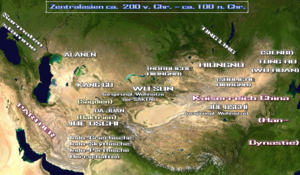Wusun

Wusun (烏孫 doslovno: "Unučad Vrane") su bili nomadski stepski narod koji je, prema kineskim historijskim tekstovima, prvotno živio sjeverozapadno od Kine kraj naroda Yuezhi. Nakon što ih je oko godine 176. pne. porazio narod Xiongnu pobjegli su u područje rijeke Ili i (jezera) Issyk Kul gdje su sljedećih pet vijekova predstavljali značajnu silu.[1][2]
Kraljevski dvor Wusuna, 赤谷 Chigu (doslovno 'Crvena dolina'), bio je smješten u jednoj od dolina koja je vodila k Issyk Kulu.[3]
Prvi put se spominju u kineskim historijskim izvorima iz 436. godine kada je kineski izaslanik poslan na njihov dvor, a Wusuni su poslije poslali jednog od svojih.[4]
Njihova kasnija sudbina se povezuje s turkijskim kaganatima i naglim promjenama u Centralnoj Aziji i, posebno, području Zhetysu. O njihovom uticaju na narode i događaje postoje brojni tragovi u perzijskim, muslimanskim, turkijskim i ruskim izvorima od 6. vijeka do danas. Suvremeni Ujsini kojih ima oko 250.000, se od nekih etnologa smatraju potomcima Wusuna. Ujsini imaju dvije grane Dulat i Sary Uysyn ("Žuti Ujsini").
Reference[uredi | uredi kod]
- ↑ Watson, Burton. Trans. 1993. Records of the Grand Historian of China. Han Dynasty II. (Revised Edition). New York, Columbia University Press. Chapter 123. The Account of Ta-yüan. Columbia University Press.
- ↑ Hulsewé, A. F. P. and Loewe, M. A. N. 1979. China in Central Asia: The Early Stage 125 BC – AD 23: an annotated translation of chapters 61 and 96 of the History of the Former Han Dynasty. Leiden: E. J. Brill.
- ↑ Hill (2009), "Appendix I: Chigu 赤谷 (Royal Court of the Wusun Kunmo)," pp. 527-531.
- ↑ Zadneprovskiy, Y. A. 1994. "The Nomads of northern Central Asia after the invasion of Alexander." Y. A. Zadneprovskiy. In: History of civilizations of Central Asia, Volume II. The development of sedentary and nomadic civilizations: 700 B.C. to A.D. 250. Harmatta, János, ed., 1994. Paris: UNESCO Publishing, p. 461
Literatura[uredi | uredi kod]
- Bartold W.W., "Four studies in history of Central Asia", Leiden, E. J. Brill, 1962
- Gardiner-Garden, J.R., Chang-Ch'ien and Central Asian Ethnography in: Papers of Far Eastern History 33 (March 1986) p. 23-79. (Australian National University Institute of Advanced Studies Department of Far Eastern History (Canberra) ISSN 0048-2870, a survey of theories of etnic affiliations and identification of the Wusun and the Yuezhi.
- Hill, John E. (2009) Through the Jade Gate to Rome: A Study of the Silk Routes during the Later Han Dynasty, 1st to 2nd Centuries CE. John E. Hill. BookSurge, Charleston, South Carolina. ISBN 978-1-4392-2134-1.
- Hill, John E. 2004. The Peoples of the West from the Weilue 魏略 by Yu Huan 魚豢: A Third Century Chinese Account Composed between 239 and 265 CE (sic.). Draft annotated English translation. [1]
- (zh) 陈连开 (Liankai, Chen) (1999). 中国民族史纲要 (Outlines on China's Ethnicities). Beijing: China Financial and Economic Publishing House. ISBN 7-5005-4301-8.
- Mallory, J.P. and Mair, Victor H. The Tarim Mummies: Ancient China and the Mystery of the Earliest Peoples from the West. Thames & Hudson. London 2000. ISBN 0-500-05101-1.
- Stein, Aurel M. 1921. Serindia: Detailed report of explorations in Central Asia and westernmost China, 5 vols. London & Oxford. Clarendon Press. Reprint: Delhi. Motilal Banarsidass. 1980. [2]
- (zh) 王明哲. 王明哲,王炳华著. 王炳华 (Wang Mingzhe et al.) (1983). 乌孙硏究 (Research on Wusun). Urumqi: Xinjiang People's Press.
